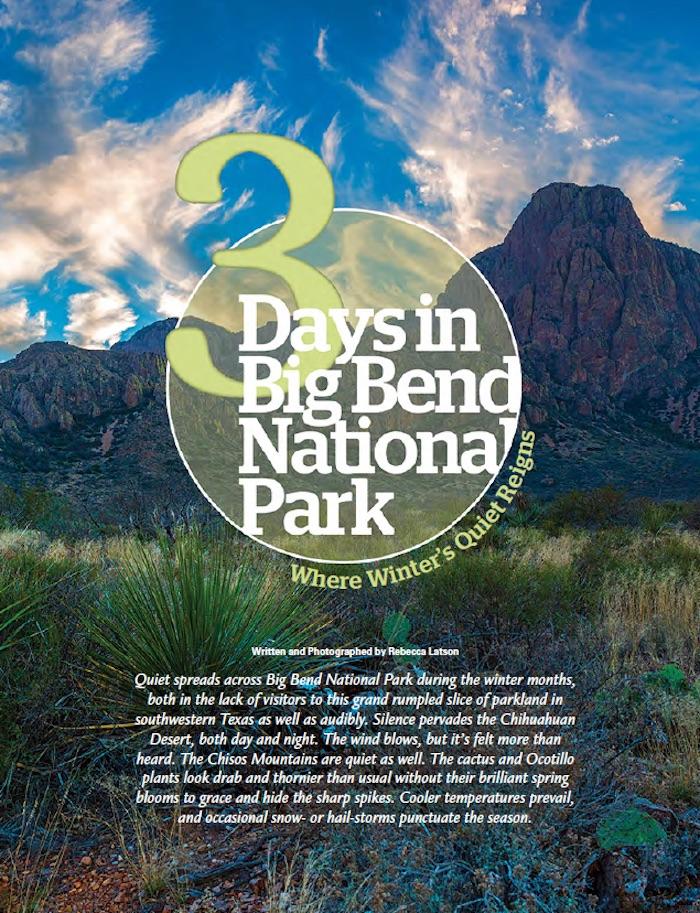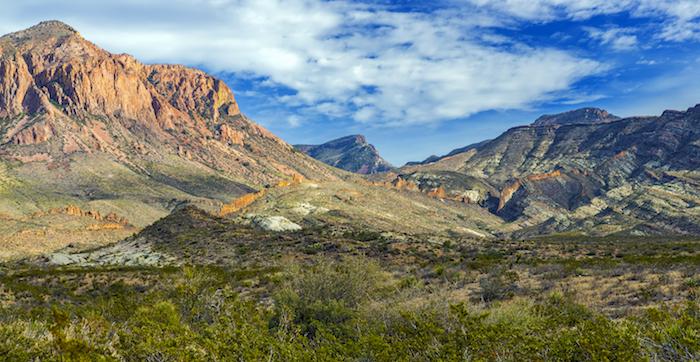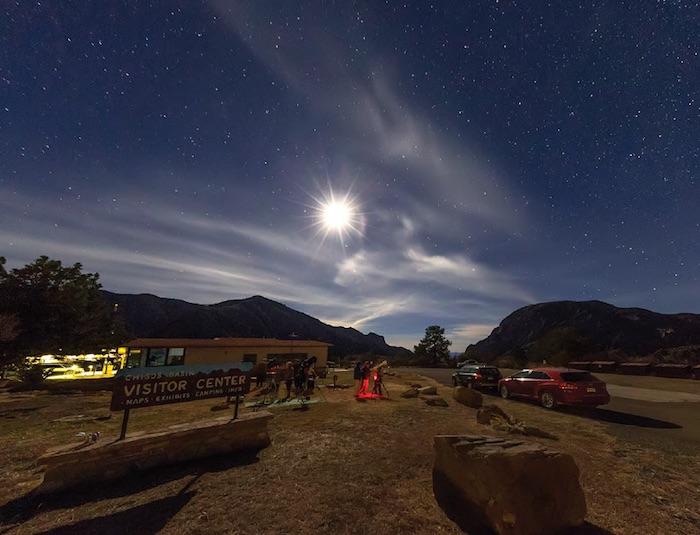
My last December visit was noticeably lacking in birdsongs, although that didn’t mean the birds were not there. I think I saw a single roadrunner dashing across the long road from the Persimmon Gap entrance to the Panther Junction Visitor Center, and that was it. The trees and tall shrubbery bore fewer leaves, and I could see all sorts of nests of varying sizes and shapes. There were, however, quite a few large, brown tarantulas crossing the road. Subsequent January, March and April trips yielded no tarantula sightings at all, which might be knowledge enough to affect the scheduling of your own winter escape to Big Bend.
Why come to Big Bend during the winter? Daytime temperatures are much milder than during the spring or summer, and the nighttime temps will be downright chilly. Park visitors are slim to none during the season. In fact, you might see more Border Patrol and National Park Service vehicles than regular tourist vehicles. If you really want to get away from it all within the contiguous United States, then this is the national park to visit.
Be sure to pack a couple of fleece or down clothing items, and a hat, as well. And make sure you always have water. Cold or hot, this national park is dry and will literally suck the moisture from your body.
Cell service is sporadic at best, and your vehicle had better be in good condition, as the closest town with any real services is Alpine, where I had to get a flat tire repaired during my most recent 2016 visit (thank you, kind Fed Ex man for being such a Good Samaritan).
The park has several large campgrounds but only one brick-and-mortar lodge: The Chisos Mountains Lodge. If you plan to visit and want to stay at the lodge, make your reservations as early as possible. Just because there are fewer park visitors doesn’t mean the lodge doesn’t fill up quickly.
Photography-wise, the winter atmospheric conditions provide nice, clear venues for great shots. If you are lucky, you’ll get some interesting cloud action in the park, as well. The sunrises and sunsets are—to me—the clearest and most colorful during the winter.
How should you navigate Big Bend in winter? There are myriad ways, but here at three suggestions to help get you thinking:
Day 1
Take a hike. And with a bit more than 801,100 acres, Big Bend offers quite a few places to take a walk. Before you head out, though, determine your fitness level. How much hiking do you think you can do and how much do you want to do? The trails I hiked were steep/narrow, rocky/slick in some places, level and/or easily traversed in others. None of the trails were that long (I’m talking anywhere from 3-5 miles), but I wasn’t in the best of shape and, being a photographer, I carried more than I should have regarding camera gear. Cameras, lenses, tripod and assorted accessories such as filters and extra batteries can get a little heavy, trust me, not to mention the addition of water and a snack or two tucked somewhere in my camera pack or in a vest pocket.

Volcanic dikes rise out of the floor of Big Bend, hinting at the park’s geologic underpinnings/Rebecca Latson
A great hike for scenic vistas is the two-mile roundtrip Grapevine Hills Trail, but be prepared for the seven miles of gravel road leading to the trailhead. From there, it’s an easy 2.2-mile walk through the maze of balanced rocks found here. A more challenging hike through Devil’s Den, a limestone slot canyon 3.5 miles south of the Persimmon Gap Visitor Center, is not quite 6 miles in length.
Among the trails in this park, a couple of very popular hikes and my personal favorites are the Lost Mine Trail and the Window Trail. Both are relatively short hikes (about 5 miles round trip, more or less), but neither is level and the end of the Window Trail might be a bit wet and slick if the water is flowing.
A short, but classic, Big Bend hike is the third-of-a-mile walk along the Window View Trail. An accessible trail that can handle wheelchairs, the paved walkway culminates with views of the “Window,” a notch in the mountains that during summer frames sunsets. During winter months the sun sets a bit left of the notch, bathing the rock walls with a golden glow; the trail offers a great appetite builder before dinner.
Day 2
Go for a drive. Ostensibly, you can see almost the entire park if you spend just a single day (or maybe a day-and-a-half) in your car driving Big Bend’s main paved road both east and west (this includes the Ross Maxwell Scenic Drive). It will be a long day, and you won’t really do any trail walking, but you will get a nice survey of the park that should help you decide what you want to do during the rest of your stay.
During your road trip, you’ll move from the vast expanse of the Chihuahuan Desert into the volcanic Chisos Mountains, created from violent eruptions as well as uplift and erosion of an ancient seabed. You’ll see textbook examples of volcanic and sedimentary geology, with some faulting and folding thrown in for good measure.
Stop off at all the viewing areas to immerse yourself in those grand vistas. Sotol Vista along the Ross Maxwell Scenic Drive is my personal favorite viewpoint and might end up being yours, too. You can see far south, beyond the notch of Santa Elena Canyon in the distance and into Mexico’s own Cañon de Santa Elena National Park, or look west toward Study Butte, or north or east into the Chisos Mountains.
If your trip is after mid-January, swing by the Fossil Discovery Exhibit that chronicles the park’s 120 million years of paleontologic history. Built thanks to the support of the Big Bend Conservancy, this exhibit found eight miles north of Panther Junction on the road to Persimmon Gap will interpret the park’s rich paleontologic and geologic history. A grand opening is set for January 14, 2017.

Some of the darkest night skies in the National Park System make stargazing a great way to end the day at Big Bend/Rebecca Latson
Day 3
Stargazing at Big Bend is a year-round practice, but it really stands out in winter thanks to the clear night air. Back in 2012 the International Dark Sky Association praised the park for its dark night skies and designated it as a Gold Tier International Dark Sky Park. A Gold Tier designation denotes a sky free from all but the most minor impacts of light pollution, a sight of increasing scarcity in North America. Measurements by the National Park Service Night Sky Team show that the Big Bend region offers the darkest measured skies in the lower 48 states.
To enjoy the star show, take a latenight drive to Sotol Vista or one of the other view areas, or simply pull over alongside the road, step outside and view the amazingly clear, starry sky. If you are very lucky, you might hear a coyote howl in the distance. If the moon is out, you can almost read by its light while still enjoying the stars. Just be careful and drive slowly because of the nocturnal creatures, like the many jackrabbits that might lope to and from either side of the road.
Of course, there are many other enjoyable diversions in Big Bend. You could explore the historic remains of the Sam Nail Ranch found along the Ross Maxwell Scenic Drive, soak in the 105-degree waters of the hot springs in the park’s Hot Springs Historic District where a bathhouse once stood, or simply relax.
That’s right, take it easy. Don’t try to see everything at once. Most people don’t believe me when I tell them this, but if you try to see too much, you come back not remembering much. You also miss the richness of spending time doing less but experiencing more in a single area of the park rather than attempting a marathon overview of the entire park.
That being said, you can definitely see a lot in three days. Just don’t push yourself. Consider your winter visit a sort of reconnaissance of the places in which you’d like to spend more time during your next trip out to Big Bend National Park.



Comments
Enjoyed reading your article! Makes me want to go back this winter!
"Of course, there are many other enjoyable diversions in Big Bend."
You hit the nail on the head. I go to Big Bend for 6-8 nights every couple of years (just got back at the end of last month) and I'm always making a list of things to do on the next trip as I'm driving home.
Definitely the underrated jewel of the system in my opinion.
How is Big Bend in January for camping? I think I just decided that I really, really, really need to head in that direction after Christmas in Phoenix.
Lee,
Either of the river campgrounds (Cottonwood, which I prefer, or Rio Grande Village), would likely be very comfortable at night, unless a real cold front moves in. By that I mean sleeping in a decent bag, and bring sweats for sleeping just in case. You may possibly just sleep in your shorts. Just like in Phoenix, the air temp will drop noticeably once the sun goes down, which of course is pretty early in January.
The Basin, on the other hand... I've camped there in February & went prepared. Gloves, long underwear, winter hat. I think one night I didn't even sleep inside my sleeping bag. You can't ever tell. Whatever the temp is in the Chisos, you'll probably be about 20deg warmer at night in either of the other campgrounds. But, in my opinion, the Basin Campground is one of the best places to camp anywhere. When you get up in the morning and step outside, you KNOW you're in a national park!
Dick in Tucson
Thanks for the article Rebecca! It was nice seeing you when you were in the Park.
As FYI for all, the Chisos campground is closed to tent camping at the moment as is the Lost Mine Trail. The bears are healthy and quite active this year, so Park-goers will need to find other places to camp. Good thing there are hundreds of thousands of acres to choose from!
Thank you, Dick. I travel with my little portable motel -- a 16ft Casita trailer -- so I'm only concerned with very cold temps that might freeze pipes. What concerns me most these days is whether or not I will need to try to reserve a campsite ahead of time or not. Any intel on that?
Actually, the Basin Campground in the Chisos is open, and I believe has not been closed at all during the bear activity, unless it was just briefly at the time of your post.
From the NPS Big Bend site on Nov 20:
"The Lost Mine Trail and some backcountry campsites in the Chisos Mountains are closed until further notice due to increased bear activity."
This is actually fewer closures in effect than when I camped in the Basin at the end of October. ALL backcountry campsites in the Chisos were closed at that time. That resulted in a lot fewer hikers than normal up there. I talked with one fellow who saw six bears on his day hike to the South Rim. I didn't even see one!
Lee,
Both the Chisos Basin Campground and the Rio Grande Village Campground take reservations for camping in January, so that's an option for you. You could check recreation.gov to see if it looks busy for your dates (if you know them) to see if you need to commit or not. That might not be a bad idea for the Chisos, because I think about 1/3 of the campground is only suitable for tents, so you're more limited in choice and even availability with your trailer. I think it's a great campgound, but I've struggled to get a spot on each of my last two visits.